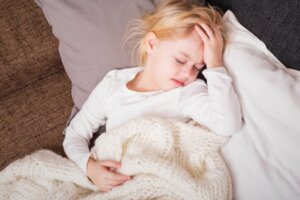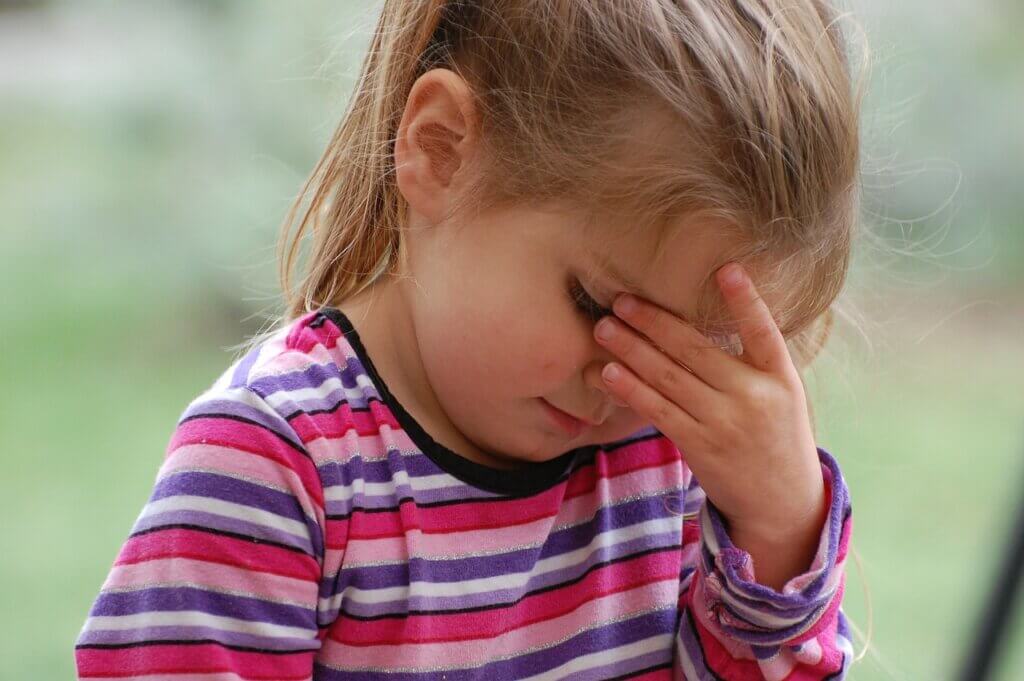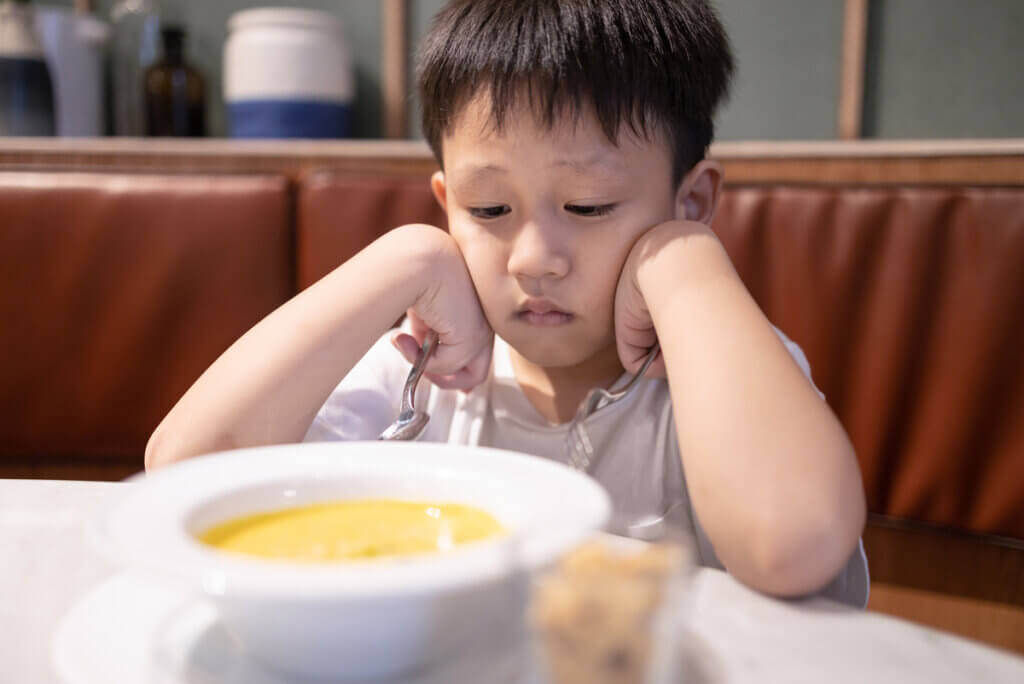Migraines in Children: What You Should Know

Although most of the time we tend to associate migraines with a discomfort typical of high levels of stress in adulthood, migraines in children are also a reality. According to some recent studies, its incidence seems to be increasing. In recent years, it’s been found in 3-20% of preschool children and adolescents, the latter accounting for the majority of cases.
Migraines in children don’t appear in exactly the same way as in adults, but they can still be very bothersome and significantly affect their quality of life. On the other hand, if it isn’t diagnosed and treated properly, it contributes to the appearance of other problems, such as depression.
Symptoms of migraines in children
Headaches are common, and these can be throbbing, vary in intensity and extent, and be classified as unilateral or bilateral. In addition to this, aura can be common. Aura is a set of manifestations that precede the headache, such as a warning that includes visual disturbances, muscle weakness and difficulties with language.
Other associated symptoms are the following:
- Sickness
- Vomiting
- Abdominal pain
- Sensitivity to stimuli such as light (photophobia), sound (phonophobia), or smells (osmophobia)
In younger children, the pain may not last too long. It may last about two hours, while in adolescents and adults it will last four hours or more on average. In all cases, symptoms seem to get worse with physical activity.
Depending on the age of the child, they may or may not be able to describe exactly what they’re feeling. Young children tend to hold their heads, cry, be irritable, and misbehave. All of this is because of the pain.

Causes
As in adults, the exact causes of migraine headaches in children are unknown. And although several theories have been raised, such as the vascular one, none has been able to cover everything that could define the origin of the disorder.
In view of this, there are experts, such as those of the Spanish Association of Pediatrics, who consider that migraine is a heterogeneous syndrome. An important genetic component would take place, influenced by exogenous and endogenous factors linked to biochemical changes.
Diagnosis of migraine in children
As the authors of an article published in Comprehensive Pediatrics state, diagnosing migraines in children can be a challenge. Often, it’s underdiagnosed, undertreated, and overlooked. In addition, the corresponding therapy isn’t carried out nor are preventive measures applied.
As we mentioned, the challenge comes, in part, from the difficulties that children may have when describing their symptoms. It’s also due to the variability of clinical manifestations and the high frequency of accompanying symptoms.
To arrive at a diagnosis of migraine, the doctor must carefully analyze the pattern of the child’s symptoms. It isn’t common for the professional to resort to imaging tests. If they do, it’ll be to rule out other causes.
In such a situation, they may request the following:
- CT scan
- MRI of the brain
- Sinus X-ray
- Lumbar puncture
In the presence of changes in levels of consciousness or cardiovascular symptoms, such as arterial hypertension or bradycardia (beats that are below the normal rate), neurological imaging should be used. They also explain that if there are no signs of increased risk or danger, then you should only resort to them if there’s a real concern in the family.
Treatment
The non-pharmacological component plays a very important role in the treatment of migraines in children and adolescents. Not only because it has been shown to help relieve the pain, but because it encourages the education of patients themselves regarding headaches and the importance of knowing how to take care of yourself.
Although it’s true that the treatment could include some drugs (analgesics such as paracetamol or ibuprofen, triptans, and antiemetics), non-pharmacological therapeutic measures are usually given greater importance. Among them, we can highlight the following:
- Maintaining adequate hydration
- Exercising regularly
- Not skipping meals
- Sleeping well
- Applying relaxation techniques
- Resting in a dark, cool, and quiet room
- Reducing or avoiding the use of electronic devices
- Conducting cognitive behavioral therapy

Prevention of migraine in children
To prevent migraine episodes in children, it’s important to help them maintain a routine, especially when it comes to sleeping and eating. On the other hand, the rest of the therapeutic measures already mentioned have proven to be very useful.
If you suspect that your child might have migraines, don’t hesitate to take them to the pediatrician for an evaluation. The sooner they get a diagnosis and initiate treatment, the sooner you can get relief and lead a good quality of life.
Although most of the time we tend to associate migraines with a discomfort typical of high levels of stress in adulthood, migraines in children are also a reality. According to some recent studies, its incidence seems to be increasing. In recent years, it’s been found in 3-20% of preschool children and adolescents, the latter accounting for the majority of cases.
Migraines in children don’t appear in exactly the same way as in adults, but they can still be very bothersome and significantly affect their quality of life. On the other hand, if it isn’t diagnosed and treated properly, it contributes to the appearance of other problems, such as depression.
Symptoms of migraines in children
Headaches are common, and these can be throbbing, vary in intensity and extent, and be classified as unilateral or bilateral. In addition to this, aura can be common. Aura is a set of manifestations that precede the headache, such as a warning that includes visual disturbances, muscle weakness and difficulties with language.
Other associated symptoms are the following:
- Sickness
- Vomiting
- Abdominal pain
- Sensitivity to stimuli such as light (photophobia), sound (phonophobia), or smells (osmophobia)
In younger children, the pain may not last too long. It may last about two hours, while in adolescents and adults it will last four hours or more on average. In all cases, symptoms seem to get worse with physical activity.
Depending on the age of the child, they may or may not be able to describe exactly what they’re feeling. Young children tend to hold their heads, cry, be irritable, and misbehave. All of this is because of the pain.

Causes
As in adults, the exact causes of migraine headaches in children are unknown. And although several theories have been raised, such as the vascular one, none has been able to cover everything that could define the origin of the disorder.
In view of this, there are experts, such as those of the Spanish Association of Pediatrics, who consider that migraine is a heterogeneous syndrome. An important genetic component would take place, influenced by exogenous and endogenous factors linked to biochemical changes.
Diagnosis of migraine in children
As the authors of an article published in Comprehensive Pediatrics state, diagnosing migraines in children can be a challenge. Often, it’s underdiagnosed, undertreated, and overlooked. In addition, the corresponding therapy isn’t carried out nor are preventive measures applied.
As we mentioned, the challenge comes, in part, from the difficulties that children may have when describing their symptoms. It’s also due to the variability of clinical manifestations and the high frequency of accompanying symptoms.
To arrive at a diagnosis of migraine, the doctor must carefully analyze the pattern of the child’s symptoms. It isn’t common for the professional to resort to imaging tests. If they do, it’ll be to rule out other causes.
In such a situation, they may request the following:
- CT scan
- MRI of the brain
- Sinus X-ray
- Lumbar puncture
In the presence of changes in levels of consciousness or cardiovascular symptoms, such as arterial hypertension or bradycardia (beats that are below the normal rate), neurological imaging should be used. They also explain that if there are no signs of increased risk or danger, then you should only resort to them if there’s a real concern in the family.
Treatment
The non-pharmacological component plays a very important role in the treatment of migraines in children and adolescents. Not only because it has been shown to help relieve the pain, but because it encourages the education of patients themselves regarding headaches and the importance of knowing how to take care of yourself.
Although it’s true that the treatment could include some drugs (analgesics such as paracetamol or ibuprofen, triptans, and antiemetics), non-pharmacological therapeutic measures are usually given greater importance. Among them, we can highlight the following:
- Maintaining adequate hydration
- Exercising regularly
- Not skipping meals
- Sleeping well
- Applying relaxation techniques
- Resting in a dark, cool, and quiet room
- Reducing or avoiding the use of electronic devices
- Conducting cognitive behavioral therapy

Prevention of migraine in children
To prevent migraine episodes in children, it’s important to help them maintain a routine, especially when it comes to sleeping and eating. On the other hand, the rest of the therapeutic measures already mentioned have proven to be very useful.
If you suspect that your child might have migraines, don’t hesitate to take them to the pediatrician for an evaluation. The sooner they get a diagnosis and initiate treatment, the sooner you can get relief and lead a good quality of life.
- Campos Castelló J, San Antonio Arce V. Cefalea en la infancia [Internet]. Asociación Española de Pediatría. 2008 [cited 2021 Jun 27]. Available from: https://www.aeped.es/sites/default/files/documentos/30-cefalea.pdf
- Fernández Rodríguez M., Orejón de Luna G.. Migraña en la infancia. Rev Pediatr Aten Primaria [Internet]. 2012 Jun [citado 2021 Jun 27] ; 14( Suppl 22 ): 29-35. Disponible en: http://scielo.isciii.es/scielo.php?script=sci_arttext&pid=S1139-76322012000200004&lng=es. https://dx.doi.org/10.4321/S1139-76322012000200004.
- Hernández Fabián A, Ruíz-Ayúcar De La Vega I, Gómez Sánchez H. Cefalea y migraña en la infancia y adolescencia. Pediatría Integr [Internet]. 2020 [cited 2021 Jun 27];XXIV(7):393E.1-393E.17. Available from: https://www.pediatriaintegral.es/wp-content/uploads/2020/xxiv07/05/n7-393e1-17_AranzazuHdez.pdf
- Moreno-Flagge N. Migraña en niños. Rev Med Hondur [Internet]. 2014 [cited 2021 Jun 27];82(2):1–108. Available from: http://www.bvs.hn/RMH/pdf/2014/pdf/Vol82-S2-2014-19.pdf
Este texto se ofrece únicamente con propósitos informativos y no reemplaza la consulta con un profesional. Ante dudas, consulta a tu especialista.







